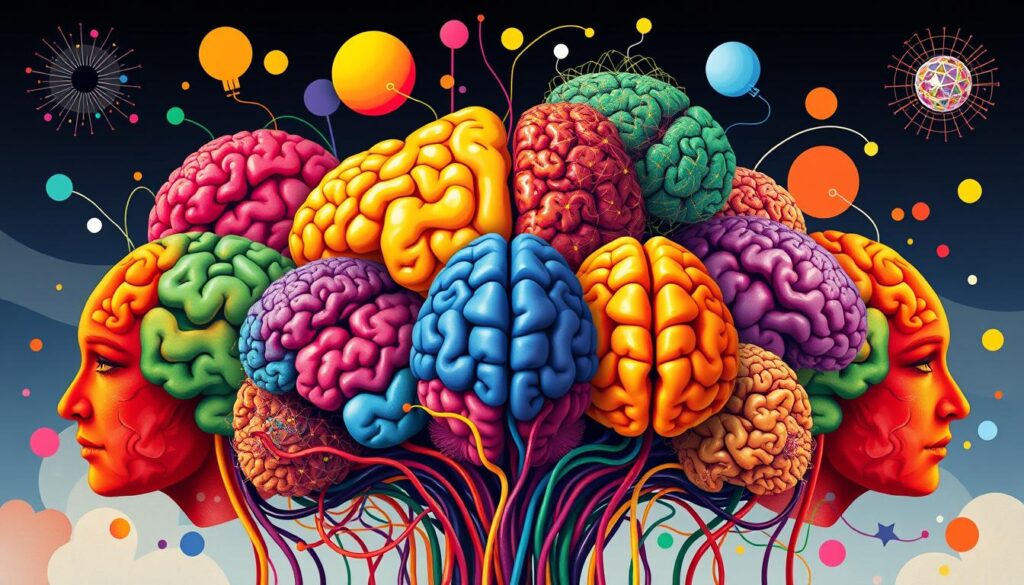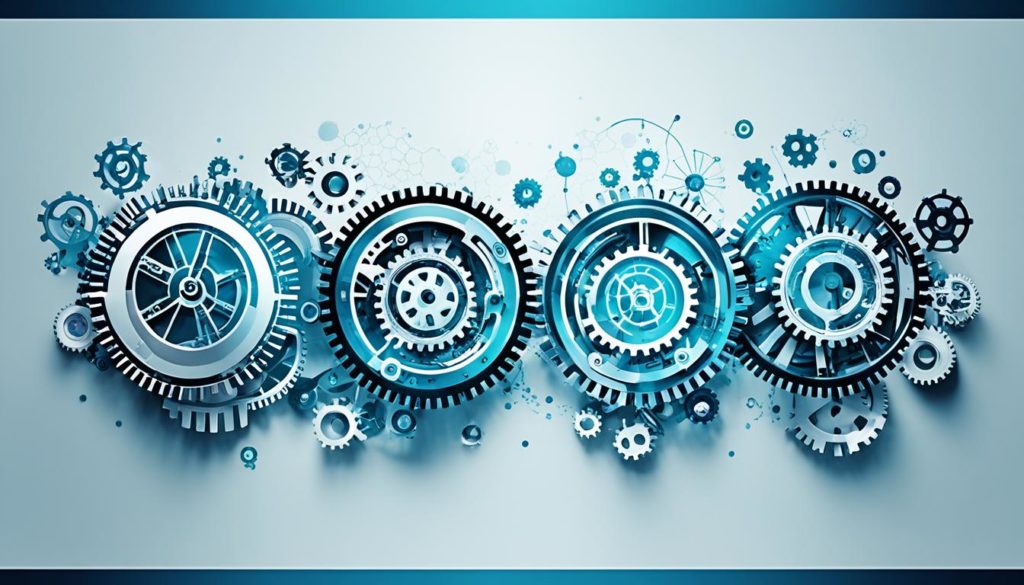
Did you know that workers in JPMorgan Chase’s Autism at Work program were up to 140% more productive than others? They also made fewer mistakes. This shows the great potential of neurodivergent people in the workplace. As we learn more about human brain differences, it’s key to support and value neurodivergent individuals.
The term neurodiversity was first used in 1997 by sociologist Judy Singer. It talks about the natural differences in brain function and behavior among people. This guide aims to explain understanding neurodiversity, focusing on the strengths and challenges of neurodivergent people. Recognizing and valuing these differences is crucial for a more inclusive society.
The Harvard Business Review suggests hiring more neurodivergent people, seeing their differences as an advantage. This change encourages us to rethink how we expect people to work. To learn more, check out this detailed article on neurodiversity.
We aim to increase acceptance and inclusion by fully exploring neurodiversity. By understanding and valuing the diverse ways our brains work, we help neurodivergent people reach their full potential. This can lead to better life management and self-acceptance.
Key Takeaways
- Workers in autism-inclusive programs can be significantly more productive and make fewer mistakes.
- The term neurodiversity was coined in 1997 to describe natural variations in brain function.
- Neurodivergence encompasses a wide range of conditions beyond autism.
- Inclusive environments and supportive workplaces can harness the unique strengths of neurodivergent individuals.
- Promoting neurodiversity awareness is crucial for fostering acceptance and inclusion in society.
Introduction to Neurodiversity
We start by looking at what is neurodiversity. This idea is key to understanding different ways people think. It was introduced in the 1990s to help people accept those with autism, ADHD, dyslexia, and more. Our exploration of neurodiversity understanding goes beyond just definitions. It shows how important this concept is in our society.
Neurodiversity shows how people see and interact with the world in unique ways. It highlights both strengths and challenges. It’s about seeing the value in neurodivergent individuals and their contributions to society.
This view has changed how we see things. It shows that differences in how we think are just part of being human.
| Key Aspect | Details |
|---|---|
| Coined | 1990s |
| Core Conditions | Autism, ADHD, Dyslexia, Dyscalculia |
| Approach | Strength-based Therapy |
| Environmental Impact | Schools, Workplaces |
The neurodiversity movement pushes for more flexible places to learn and work. Traditional settings can be too strict for some. By making places more inclusive, we help neurodiverse people reach their full potential.
Getting a diagnosis is important for facing big challenges, especially in school and social life. But the idea of neurodiversity has grown. It encourages people to identify as neurodiverse and build supportive communities.
As we go further, we’ll see how this idea promotes acceptance and celebration of neurodiversity. It’s not just a term for experts; it’s a big change towards being more inclusive and understanding of human differences.
What is Neurodiversity?
In recent years, neurodiversity has become a key part of understanding human diversity. It shows that neurological differences are a natural part of who we are. Let’s explore what neurodiversity is and its definition.
Neurodiversity Definition
Neurodiversity talks about the variety in human brains and minds. It was first used in the 1990s by Judy Singer, an Australian sociologist. It includes differences like autism, ADHD, dyslexia, and dyspraxia.
People with these differences often have unique strengths. For example, those with ADHD might be very passionate and creative. This shows that their differences are not weaknesses.
The neurodiversity approach suggests we should focus on what each person can do well. It’s not about fixing differences, but about valuing them. This way, we can make our society more diverse and richer.
For more information on neurodiverse conditions and their impact, check out this resource.
Historical Context
The way we see neurological differences has changed a lot. At first, these differences were seen as problems to fix. But now, we understand that they are a natural part of human diversity.
This change in view has helped us see the strengths of neurodivergent individuals. Traits like spontaneity and focus in ADHD, or attention to detail in autism, are valuable. They helped our ancestors survive and are still important today.
To truly value neurodiversity, we need to keep growing. We must create spaces where everyone’s unique abilities are celebrated and used.
Importance of Neurodiversity
Understanding and valuing neurodiversity changes how we see human differences. It helps us create places where everyone can do their best. This means everyone gets to use their unique talents.
Fostering Inclusive Environments
It’s key to make classrooms and workplaces welcoming. A Deloitte study shows teams with neurodivergent members can be 30% more productive. This shows how being inclusive can lead to better results and more work done.
JPMorgan Chase found that neurodivergent employees are 90% to 140% more productive. They also make fewer mistakes. This shows the value of neurodiversity in the workplace.
But, many companies still struggle to accept neurodiversity. Only 20% of Fortune 500 companies want to hire people with severe mental disabilities. Yet, over 90% are open to hiring those with physical disabilities.
By focusing on neurodiversity, companies can find new talent and succeed. Programs like those at EY, SAP, and Microsoft show how well neurodiverse employees can do. They have retention rates over 90%.
Celebrating Unique Perspectives
Neurodiversity brings new ideas and solutions to our communities and workplaces. People with neurodiversity often find creative ways to solve big problems. For example, an SAP employee saved the company $40 million with a technical fix.
Having neurodiverse programs makes employees feel their work matters. This boosts their happiness and involvement. A 2022 Glassdoor study found that DEI efforts, including neurodiversity, attract more job seekers.
By being inclusive, we support diverse thinking and creativity. This is crucial for our modern world.
| Aspect | Impact |
|---|---|
| Productivity | Teams with neurodivergent members may be up to 30% more productive. |
| Retention | Over 90% retention rates in neurodiverse programs at companies like JPMorgan Chase, EY, SAP. |
| Innovation | Neurodivergent individuals like those at SAP contribute significant innovations, such as $40 million in technical fixes. |
| Engagement | DEI initiatives including neurodiversity boost employee engagement and attract diverse job seekers. |
Neurodiversity in the Workplace
It’s important to see the value of neurodiversity in the workplace for real inclusion. When we get the strengths and challenges of neurodivergent people, we can make better work places.
Challenges and Opportunities
Neurodivergent workers often face big hurdles in the workplace. They might struggle with communication and be sensitive to things like loud noises. But, if we focus on workplace inclusion, we can turn these problems into chances for growth.
Things like quiet spots, flexible meeting times, and doodling can really help. They make work better for everyone.
Importance of Awareness
It’s key to raise awareness in employment about neurodiversity. Podcasts and special training help teach everyone. Tools like the Inclusive Employers Inclusion Passport help managers talk about what each person needs.
It’s also important to keep checking and changing support. Many neurodivergent people are still figuring out how their traits affect work. By focusing on real steps, we can meet the needs of our diverse team.
Examples of Successful Inclusion
Good strategies for inclusion involve looking at and fixing bias. For example, using fidget toys or flexible work models can really help. Training managers in skills like communication and inclusion is also key.
Companies that do these things create better work places. They also get the special talents and views of neurodivergent workers.
| Company Initiative | Benefit |
|---|---|
| Inclusive Employers Inclusion Passport | Facilitates supportive conversations |
| Hybrid Working Environments | Flexible participation, reducing stress |
| Quiet Work Areas | Provides space for deep work |
| Line Manager Training | Improves support for neurodivergent employees |
| Use of Fidget Toys | Helps maintain focus during meetings |
Companies like Leantime, led by Gloria Folaron, show how to fight stigma. By understanding and supporting neurodivergent workers, we can make workplaces more inclusive and creative.
Common Neurodivergent Conditions
It’s important to know about neurodivergent conditions to support everyone. We’ll look at ASD, ADHD, dyslexia, and dyspraxia. Each one affects people differently, changing how they learn, work, and interact with others. We need to tailor support and accommodations for each person.
Autism Spectrum Disorder (ASD)
ASD makes social skills, repetitive behaviors, and communication hard. The CDC says 2.3% of kids have ASD, or about 1 in 44 in the U.S. People with ASD see the world differently and might be really good at some things. It’s key to use their strengths in different places.
Understanding neurodiversity helps those with ASD do well. It’s about knowing and using their unique traits and needs.
Attention Deficit Hyperactivity Disorder (ADHD)
ADHD is a common disorder marked by forgetfulness, fidgeting, and trouble focusing. About 9.4% of kids have ADHD before they grow up. A structured setting and specific strategies can help manage ADHD symptoms.
Dyslexia
Dyslexia affects about 20% of people and is often spotted in school. It makes reading, writing, and speaking hard. Special education and technology can help those with dyslexia overcome these hurdles.
Dyspraxia
Dyspraxia, or DCD, makes movement and coordination hard. It affects writing and other tasks. Occupational therapy and personal support plans can help those with dyspraxia succeed.
Learning about and supporting neurodivergent conditions is key to a better world. By understanding and valuing the strengths and challenges of ASD, ADHD, dyslexia, and dyspraxia, we make our communities more inclusive.
Conclusion
Understanding and promoting neurodiversity is key to a better society. It helps create places where everyone can do their best. This way, we make our communities richer with different views and talents.
In the U.S., about 85% of autistic people are not working or are underemployed. Yet, they often have skills as good as or better than others. This shows we need to accept neurodiversity more in our jobs.
Worldwide, programs like JPMorgan Chase’s Autism at Work have shown great success. They saw a 48% boost in productivity. This proves that supporting neurodiversity helps everyone, not just those who are different.
We must keep pushing for better support and chances in work, school, and community. By truly including everyone, we make our society fairer and more productive. Our dedication to this will help build stronger, more diverse communities.
FAQ
What is neurodiversity?
Neurodiversity is about accepting that brain differences, like autism and ADHD, are normal. It sees these differences as adding to human diversity, not as flaws.
Why is understanding neurodiversity important?
It’s key because it helps us make places where everyone can do their best. By embracing brain differences, we get more creativity and problem-solving. This makes our communities and workplaces better.
How can we foster inclusive environments for neurodiverse individuals?
We can do this by understanding and meeting each person’s needs. Schools and workplaces should make changes to help. It’s also important to spread awareness and value different ways of thinking.
What are some examples of successful inclusion in the workplace?
Companies like Microsoft and SAP show how it works. They offer flexible hours and quiet spaces. This helps neurodivergent employees contribute and makes the workplace more innovative.
What challenges do neurodivergent individuals face in professional settings?
They often struggle with workplace cultures and communication. Sensory issues can also be a problem. But, with the right support, workplaces can become more inclusive and productive.
Can you explain the term ‘celebrating neurodiversity’?
It means valuing the unique strengths and views of neurodivergent people. It’s about seeing their differences as assets that bring innovation and creativity.
How do conditions like autism, ADHD, dyslexia, and dyspraxia affect individuals?
Each condition affects people in different ways. Autism can change how they interact and process sensory information. ADHD, dyslexia, and dyspraxia impact focus, reading, and motor skills. Understanding and supporting these needs helps neurodivergent individuals succeed.
What is the historical context of neurodiversity?
The term ‘neurodiversity’ started in the 1990s. It marked a shift from seeing differences as deficits to seeing them as enriching. This change shows growing respect for neurodivergent individuals.
Why is promoting neurodiversity awareness important?
It’s vital for creating a society that accepts and supports neurodivergent people. Awareness helps remove stigmas and ensures everyone can contribute their best.
How can we support neurodivergent individuals in educational settings?
We should recognize their unique learning needs and provide tailored strategies. Teachers need to understand neurodiversity too. This helps neurodivergent students do well academically and socially.
Future App Studios is an award-winning software development & outsourcing company. Our team of experts is ready to craft the solution your company needs.










